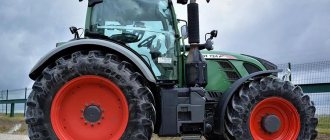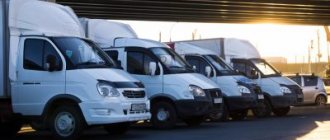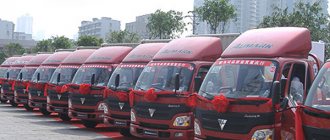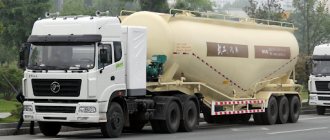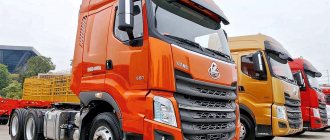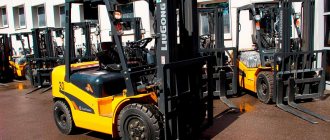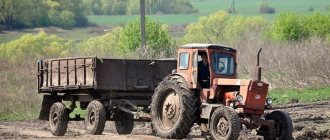Definition of the concept of “vehicle”. Explanations of the Supreme Court of the Russian Federation
Vehicle is a device intended for transporting people, cargo or equipment installed on it on roads (Article 2 of the Federal Law of December 10, 1995 N 196-FZ “On Road Traffic Safety”)
Paragraph 2 of the Resolution of the Plenum of the Supreme Court of the Russian Federation dated June 25, 2019 N 20 “On some issues arising in judicial practice when considering cases of administrative offenses provided for by Chapter 12 of the Code of Administrative Offenses of the Russian Federation” contains the following explanations:
“In Chapter 12 of the Code of Administrative Offenses of the Russian Federation, vehicles are understood to mean:
- motor vehicles subject to state registration with an internal combustion engine displacement of more than 50 cubic centimeters and a maximum design speed of more than 50 kilometers per hour,
- motor vehicles subject to state registration with a maximum electric motor power of more than 4 kilowatts and a maximum design speed of more than 50 kilometers per hour,
- trailers for the specified motor vehicles subject to state registration,
- tractors, self-propelled road construction and other self-propelled machines,
- vehicles for which, in accordance with the legislation of the Russian Federation on road safety, a special right is granted (for example, a moped).
At the same time, the concept of a vehicle, enshrined in the note to Article 12.1 of the Code of Administrative Offenses of the Russian Federation, is not subject to a broad interpretation. At the same time, in the cases provided for in individual articles of Chapter 12 of the Code of Administrative Offenses of the Russian Federation, administrative liability is also established for persons driving other means of transportation (in particular, bicycles, horse-drawn carts), if such persons violate traffic rules of the Russian Federation (for example, parts 2 and 3 of Article 12.29 of the Code of Administrative Offenses of the Russian Federation) "
In paragraph 2 of the Resolution of the Plenum of the Supreme Court of the Russian Federation dated December 9, 2008 N 25 (as amended on May 24, 2016) “On judicial practice in cases of crimes related to violation of traffic rules and operation of vehicles, as well as their unlawful seizure without purpose of theft" contains the following explanations:
“ Mechanical vehicles in Articles 264 and 264.1 of the Criminal Code of the Russian Federation mean cars, buses, trolleybuses, trams, motorcycles, quadricycles, mopeds, and other vehicles for which a special right is granted in accordance with the legislation of the Russian Federation on road safety, as well as tractors, self-propelled road construction and other self-propelled machines.
Persons who drove vehicles other than the specified mechanical vehicles (for example, bicycles) and committed a violation of traffic safety rules or the operation of vehicles, which through negligence resulted in the infliction of serious harm to health or the death of a person, if there are grounds for this, are liable accordingly according to Parts 1, 2 or 3 of Article 268 of the Criminal Code of the Russian Federation.”
Recommended publications on the topic:
- Driving a vehicle is .. Concept, judicial practice
- The driver of a vehicle is .. Definition of the concept, judicial practice
- The owner of the vehicle, the driver is... Definition of the concept
What is a self-propelled vehicle, control rules
The definition of self-propelled transport is in the Decree of the Government of the Russian Federation No. 796 of July 12, 1999 (section General provisions). The second paragraph states that a self-propelled vehicle is a vehicle, has an independent drive, and an internal combustion engine with a volume of 50 cm3 or more. If an electric motor is installed, then its power must be greater than 4 kW.
Based on the above, self-propelled vehicles include tractors, machines for road construction work, mechanical vehicles that are capable of moving on the road, but are not road users.
But there are exceptions: self-propelled vehicles do not include motor vehicles whose speed is higher than 50 km/h, as well as self-propelled combat equipment of the Russian Armed Forces.
The main task of a self-propelled machine is to perform certain types of work. It is not used for moving or transporting anything. The equipment is registered with the State Technical Supervision Authority.
Driving self-propelled vehicles when driving on the roadway is subject to the general requirements of traffic rules: adherence to the speed limit, attention on the road, compliance with the requirements of signs and traffic lights. The exception is vehicles used for certain work on the road. This applies to snow removal equipment, municipal vehicles and special equipment for road construction.
Age for obtaining a tractor license
In order to be able to drive a tractor, a tractor driver's license is required. The certificate contains 6 categories and 4 subcategories. Each item has its own age limit:
- Category A. Here are vehicles that never drive onto the roadway.
- Subcategory I – motorized off-road vehicles. Permitted from 16 years of age;
- Subcategory II – off-road vehicles weighing up to 3500 kg and no more than 8 passenger seats (mining dump trucks and all-terrain vehicles). Permitted from 19 years of age;
- Subcategory III – vehicles for off-road driving, weight from 3500 kg with the exception of vehicles from subcategory IV (mining dump trucks and all-terrain vehicles). Permitted from 19 years of age;
- Subcategory IV - Vehicles for off-road driving, with more than 8 passengers (Apron and rotational buses). Permitted from 22 years of age.
- Category B. Tractors on wheels and on tracks, with motor power up to 25.7 kW.
- Category C. Tractors on wheels, power in the range of 25.7 - 110.3 kW. Permitted from 17 years of age.
- Category D. Tractors on wheels, power from 110.3 kW. Permitted from 18 years of age.
- Category E. Tractors on tracks, power from 25.7 kW. Permitted from 17 years of age.
- Category F. Self-propelled machines, combines. Permitted from 17 years of age.
The concept and types of vehicles in the law
Paragraph 11 of Article 1 of Law No. 16-FZ dated 02/09/2007 “On Transport Safety” provides the definition of the concept of “vehicle” and the types of vehicles:
Vehicles are devices intended for the transportation of individuals, cargo, baggage, hand luggage, personal belongings, animals or equipment, devices installed on said vehicles, in the meanings defined by transport codes and charters, and including:
a) vehicles used for regular transportation of passengers and luggage or transportation of passengers and luggage on order, or used for the transportation of dangerous goods, which requires a special permit;
b) commercial civil aviation aircraft;
c) general aviation aircraft , determined by the Government of the Russian Federation on the proposal of the federal executive body exercising the functions of developing state policy and legal regulation in the field of transport, agreed with the federal executive body in the field of ensuring the security of the Russian Federation, the federal executive body authorities performing the functions of developing state policy and legal regulation in the field of internal affairs;
d) vessels used for the purposes of merchant shipping (sea vessels) , with the exception of pleasure craft, sports sailing vessels, as well as artificial installations and structures that are created on the basis of offshore floating platforms and the features of protection of which from acts of unlawful interference are established in accordance with Article 12.3 of this Federal Law;
e) vessels used on inland waterways for the transportation of passengers, with the exception of pleasure craft, sports sailing vessels, and (or) for the transportation of high-risk cargo, permitted for transportation under special permits in the manner established by the Government of the Russian Federation on the proposal of the federal executive body authorities exercising the functions of developing state policy and legal regulation in the field of transport, agreed upon with the federal executive body in the field of ensuring the security of the Russian Federation, the federal executive body exercising functions of developing state policy and legal regulation in the field of internal affairs ;
f) railway rolling stock carrying out the transportation of passengers and (or) high-risk cargo permitted for transportation under special permits in the manner established by the Government of the Russian Federation on the proposal of the federal executive body exercising the functions of developing state policy and legal regulation in the field transport, agreed with the federal executive body in the field of ensuring the security of the Russian Federation, the federal executive body exercising the functions of developing state policy and legal regulation in the field of internal affairs;
g) urban ground electric transport vehicles.
Concept and types of vehicles in the Rules of the Road
Clause 1.2 of the Traffic Rules, approved by Resolution of the Council of Ministers - Government of the Russian Federation dated October 23, 1993 N 1090, provides definitions of the following vehicles:
Bicycle is a vehicle, other than a wheelchair, that has at least two wheels and is generally propelled by the muscular energy of the occupants of the vehicle, in particular by means of pedals or handles, and may also have an electric motor with a rated maximum power in the mode continuous load not exceeding 0.25 kW, automatically switching off at speeds over 25 km/h.
A hybrid vehicle is a vehicle that has at least 2 different energy converters (motors) and 2 different energy storage systems (on-board) for the purpose of propelling the vehicle.
Route vehicle is a public vehicle (bus, trolleybus, tram) intended for transporting people on roads and moving along a set route with designated stopping places.
A motor vehicle is a vehicle driven by an engine. The term also applies to any tractors and self-propelled machines.
Moped is a two- or three-wheeled mechanical vehicle, the maximum design speed of which does not exceed 50 km/h, having an internal combustion engine with a displacement not exceeding 50 cubic meters. cm, or an electric motor with a rated maximum power in continuous load mode of more than 0.25 kW and less than 4 kW. Quadricycles with similar technical characteristics are considered equal to mopeds.
A motorcycle is a two-wheeled motor vehicle with or without a side trailer, the engine displacement of which (in the case of an internal combustion engine) exceeds 50 cc. cm or the maximum design speed (with any engine) exceeds 50 km/h. Motorcycles are considered tricycles, as well as quadricycles with a motorcycle seat or motorcycle-type handlebars, having an unloaded weight not exceeding 400 kg (550 kg for vehicles intended for the transport of goods), excluding the weight of batteries (in the case of electric vehicles), and the maximum effective engine power not exceeding 15 kW.
A trailer is a vehicle that is not equipped with an engine and is intended to be driven in conjunction with a power-driven vehicle. The term also applies to semi-trailers and trailers.
Vehicle is a device designed to transport people, goods or equipment installed on it on roads.
A school bus is a specialized vehicle (bus) that meets the requirements for vehicles for transporting children, established by the legislation on technical regulation, and is owned by right of ownership or on another legal basis to a preschool educational or general education organization.
An electric car is a vehicle driven solely by an electric motor and charged by an external source of electrical power.
Working categories
In addition to opening a certain category of license, tractor drivers regularly undergo certification and advanced training. After passing exams and meeting standards, the following categories are assigned:
- 2nd category. Gives the right to operate equipment under the supervision of an experienced tractor driver.
- 3rd category. Independent control, carrying out load-handling work using special devices, unloading.
- 4th category. Operation of machines with a power of up to 100 hp, carrying out unloading and loading operations, warehousing and moving goods over a distance.
- 5th category. Self-propelled machines with an engine greater than 100 hp, such as crawler excavators and bulldozers.
- 6th category. Control of large self-propelled equipment, tractors, bulldozers, excavators with power above 200 hp.
Regardless of the category being opened, rights to a tractor are obtained only after completing special training in an organization licensed by Gostekhnadzor. Exams are taken at the departmental body.
Vehicle identification
The concept of a vehicle includes both road transport and other types of devices intended for the transport of people and goods.
Specifying only the make, model and year of manufacture cannot individualize a vehicle. Its unique features are also:
- identification number of the vehicle passport;
- vehicle identification number (VIN);
- state registration plate;
- body, chassis, engine number;
- category, type;
- cabin and body color.
To identify other types of vehicles subject to registration or registration, we recommend providing the information required for such registration. As individualizing features, you can specify the numbers assigned earlier during the registration of the vehicle (the rights to it).
Documents identifying the vehicle
In accordance with Article 14 of the Law dated 08/03/2018 N 283-FZ “On state registration of vehicles in the Russian Federation and on amendments to certain legislative acts of the Russian Federation”, which comes into force on 01/01/2020, documents identifying the vehicle, are:
1) vehicle passport (vehicle chassis passport); 2) registration document.
Registration documents are:
1) vehicle registration certificate; 2) registration documents established by the regulatory legal acts of the Russian Federation, the RSFSR, the USSR, issued before 1993, including a vehicle registration certificate, a vehicle technical passport, a vehicle technical certificate.
Categories of vehicles for transporting passengers and luggage “M1”, “M2”, “M3”
Clause 2 of the Rules for the transportation of passengers and luggage by road and urban ground electric transport, approved by Decree of the Government of the Russian Federation of February 14, 2009 N 112, provides for the following categories of vehicles:
A vehicle of category “M1” is a vehicle that is used to transport passengers and has, in addition to the driver’s seat, no more than 8 seats; A vehicle of category “M2” is a vehicle that is used to transport passengers, has more than 8 seats in addition to the driver’s seat and whose maximum weight does not exceed 5 tons; A vehicle of category “M3” is a vehicle that is used to transport passengers, has more than 8 seats in addition to the driver’s seat and has a maximum weight exceeding 5 tons.
Luggage vehicle is a vehicle that transports luggage separately from passengers; Passenger taxi is a vehicle of category “M1”, used for the transportation of passengers and luggage in accordance with a public charter agreement.
Is it possible to get a tractor license if you have lost your driver's license?
This question is very common not only among beginners, but also among experienced farmers. As mentioned above, deprivation of a driver’s license to use a car automatically prohibits the driver from driving the tractor at his disposal. But is it possible to get a separate license to drive a tractor exclusively? The answer is quite simple - the law does not prohibit this.
To do this, you will need to prepare a list of the following documents:
- application filled out by hand in accordance with the sample;
- a certificate confirming the absence of health problems;
- passport or a copy thereof;
- photographs of the required sizes;
- if necessary, a driver’s license for categories AII, AIII and AIV;
- a document confirming that a person knows the traffic rules for a tractor.
It should be immediately noted that the traffic rules for a tractor are not very different from the rules of the road for a car. During the cadet's training, he is taught the features of operating a tractor, which are slightly different from driving a car. At the same time, the decoding of road signs, road markings and other rules remains unchanged. To pass the tractor traffic rules, the future tractor driver should contact the nearest department of Gostekhnadzor, having with him a certificate of completion of the course and a previously prepared application. Gostekhnadzor is also responsible for issuing tractor licenses.
Having received the necessary documents, many people deprived of their right to drive a car rush to get on a tractor. However, this is absolutely impossible to do, because, as mentioned above, as a result of deprivation of a driver’s license, a person is automatically deprived of the right to drive a tractor, even if he has received a separate tractor license for this.
The term “vehicle” in the Technical Regulations of the Customs Union
In paragraph 6 of the Technical Regulations of the Customs Union “On the safety of wheeled vehicles”, adopted by the decision of the Customs Union Commission dated December 9, 2011 N 877, the following concepts of vehicles are defined:
Road train is a vehicle formed by a car and a semi-trailer or trailer (trailers) towed by it; Off-road heavy-duty vehicles - mechanical vehicles, by design and purpose, specially designed for the transportation of large-sized and (or) heavy cargo, primarily outside public roads, in which one of the parameters exceeds the permissible standards established by law for travel on public roads, and the mass per at least one axle exceeds 10 tons; Hybrid vehicle is a vehicle that has at least two different energy converters (motors) and two different energy storage systems (on-board) for the purpose of propelling the vehicle; Innovative vehicle - a vehicle in which new design solutions are applied that qualitatively change its main performance indicators, and which cannot be assessed in accordance with these technical regulations; Complete vehicle - a vehicle suitable for use in accordance with its purpose; A vehicle that has not been completed by production is a vehicle that requires completion for its operation; Articulated vehicle - a vehicle that consists of two or more rigid sections articulated with each other, the separation of which can only be done with the help of special equipment; Specialized passenger vehicle - a vehicle of category M2G or M3G, manufactured on the chassis of an off-road vehicle of category N1G, N2G or N3G; Specialized vehicle - a vehicle intended for the transportation of certain types of cargo (petroleum products, food liquids, liquefied hydrocarbon gases, food products, etc.); Special vehicle - a vehicle designed to perform special functions that require special equipment (truck cranes, fire trucks, vehicles equipped with lifts with working platforms, tow trucks, etc.); Vehicle is a wheeled device of categories L, M, N, O, intended for the transportation of people, cargo or equipment installed on it.
Transport vehicles are designed to transport goods and passengers, and depending on the transportation performed, they can be cargo or passenger.
Trucks are divided into general purpose and specialized vehicles; the former have a platform with sides, and the latter are equipped with a special body for transporting building materials, food, liquids, etc. The main indicator of trucks is their rated load capacity.
According to their carrying capacity, trucks are divided into classes: extra small - up to 0.5 tons; small - from 0.5 to t, medium - from to t; large - from to t; especially large - over t.
Vehicles adapted for towing trailers and semi-trailers are called towing vehicles. A tractor or truck together with one or more trailers forms a road train,
Depending on their adaptability to road conditions, a distinction is made between normal (ordinary) and all-terrain vehicles. The former have a drive on one axle, the latter - on two or three axles, which allows them to overcome off-road conditions or bad sections of the road.
By engine type, the most common vehicles are those with carburetor and diesel internal combustion engines.
Based on the type of load-bearing element, cars can be divided into frame (trucks) and frameless (a number of cars and buses).
The model of a domestic car consists of a brand (letters indicating the manufacturer) and numbers assigned to each model. For example, Gorky Automobile Plant - GAZ, Minsk Automobile Plant - MAZ, etc.
When an automobile plant produces several cars, assembled mainly from identical units, the car model produced in the largest quantity is called the base one. Other models that differ from the basic one in the installation of special bodies, and sometimes in the size of the base (the distance between the wheel axles), are called modifications. Modifications are given their own designation.
In the designation of the base model, the first digit indicates the class of the car, the second its type, and the third and fourth digit the serial number. For example, KamAE-5320 means: - heavy-duty vehicle; — flatbed truck; 20 is the serial number of the model.
Five- and six-digit numbers are used to indicate modifications. For example, a modification of the KamAZ-5320 truck is designated KamAZ-53202.
A tractor is a wheeled or tracked self-propelled machine designed to move and work together with trailed or mounted road, agricultural and other machines and implements.
Tractors are used in all sectors of the national economy, performing a wide variety of work in various conditions. It is almost impossible to create universal machines that work equally well and economically in all diverse conditions. Therefore, a type of tractor has been created in our country.
A type is a set of types and models indicating their main quality indicators. The type of the country's tractor fleet includes all models of tractors in operation and produced by factories.
A class in a type is a collection of models that have the same basic classification parameters. A specific design of a tractor is usually called a model. The base model is the most common type of tractor in this class. A modification is a model that belongs to the same class as the base vehicle and is completely unified with it. The modification has a different layout from the base machine or is equipped with additional mechanisms.
In the type of tractor fleet, each class of tractor is usually represented by at least two models: one - produced and the second - already discontinued, but still in use in the national economy.
Currently, in the USSR and CMEA countries, the main classification parameter is the nominal traction force on the hook. In addition, classification is carried out according to other criteria: purpose, chassis design, types of frame, engine and transmission. According to the nominal traction force (expressed in tons), tractors are divided into classes: 0.2; 0.6; 0.9; 1.4; 2; 3; 4; 5; 6; 8; 10; 15, 25 and 35 tons and a number of modifications.
In the process of implementing the type, new models of tractors were put into production and prepared for release, corresponding to the world level of technology development and used in the construction and operation of highways: wheeled MTZ-80 and its modifications of the 1.4 tf class, T-150K tf class, K -701 vehicle class, etc.; tracked - DT-75M, T-150 and their modifications of the vehicle class; T-100M and T-130 vehicle class; DET-250M class 25 tf, etc.
According to their purpose, tractors can be divided into agricultural, industrial, transport and special purpose.
Agricultural tractors, depending on the characteristics of the agricultural work performed, are divided into arable (T-4M, DT-75M, T-130, etc.) and universal row-crop tractors (T-40M, MTZ-80, MTZ-82, DT-2, etc. .). The industrial group includes tractors designed to perform heavy earth-moving, road-building, reclamation and other work (DET-250, T-130M, T-180, etc.). Transport tractors are intended for transporting goods mainly on off-road and unpaved roads. roads. The speed of such tractors and the power of their engines vary within fairly wide limits. Special-purpose tractors are designed to perform special work, as a result of which they have additional equipment: winches, grabs, lifts, etc. (TT-4, TDT-55, LHT-55M, etc.). Tractors MTZ-80, DT-75M, T-130 and others are widely used both in agriculture and in construction.
According to the design of the chassis, tractors are either wheeled or tracked. Crawler tractors are characterized by a reduced specific pressure on the ground, which increases their maneuverability. However, they are heavier than wheeled ones, more complex and expensive to manufacture and operate.
Based on the type of frame, tractors are divided into frame, semi-frame and frameless. The frame of frame tractors is a riveted or welded frame on which all units and mechanisms of the tractor (DT-75M, etc.) are installed and fastened. The frame of semi-frame tractors has two longitudinal beams screwed or welded to the rear axle housing and a cross member connecting the beams in the front part (MTZ-80, T-130, etc.). The frame of frameless tractors is formed by connecting the crankcases of units (T-25A, etc.) to each other.
—
The rolling stock of road transport is divided into transport (freight and passenger) and special purpose (firefighting, truck cranes, utility, ambulance and other vehicles).
Transport trucks and road trains are divided into universal (with a flatbed body) and specialized, adapted for transporting one or more specific types of cargo (dump trucks, vans, tanks, panel trucks, farm trucks, etc.). An semi-trailer can consist of a car with a trailer or a truck tractor with a semi-trailer.
Passenger vehicles include buses and cars. By purpose, buses are divided into city, suburban, intercity, local, tourist, excursion, and school. The capacity of buses is characterized by their length: up to 5 m (extra small), 6–7.5 m (small), 8–9.5 m (medium), 10–12 m (large), 16.5–24 m (extra big). Depending on the destination, the capacity of buses of the same length may be different.
Passenger cars vary in engine cylinder displacement (displacement): up to 1.2 liters (extra small), 1.2-1.8 liters (small), 1.8-3.5 liters (medium) and more than 3.5 l (large).
In our country, passenger cars are produced by the Zaporozhye automobile plant (ZAZ-966 and ZAZ-968 Zaporozhets), the Volga automobile plant named after the 50th anniversary of the USSR (VAZ-2101 and BA3-2103 Zhiguli), the Moscow automobile plant named after Lenin Komsomol and Izhevsk automobile) Gorky Automobile),
Buses are produced by Riga, Kurgan, Pavlovsk named after A. A. Zhdanov, Lvov and Likinsky (Moscow region) bus factories.
Cars with a carrying capacity of 0.8-1.0 tons are produced by the Ulyanovsk V.I. Lenin and Yerevan Automobile Plants.
Vans (0.25-0.4 tons) based on the Moskvich car are manufactured by the Moscow Lenin Komsomol Plant and the Izhevsk Automobile Plant.
Medium-duty trucks are produced by the Gorky Automobile Plant and the Moscow Automobile Plant named after. I. A. Likhacheva. The main models are GAZ-BZA (load 0.. lifting capacity 4 tons) and ZIL-130 (load capacity 5 tons). The Saransk dump truck plant, based on the GAE-53A vehicle, produces GAE-53B dump trucks (3.5 tons).
Based on the ZIL-130 vehicle, the I. A. Likhachev Automobile Plant produces the EIL-130V1 truck tractor and the ZIL-130G vehicle for transporting long loads, and the Mytishchi Machine-Building Plant produces the ZIL-MMZ-555 (4.5 t) and agricultural ZIL-555 dump trucks. MMZ-554 (4 t).
KAZ-608 Kolkhida truck tractors are also produced by the Kutaisi Automobile Plant named after G.K. Ordzhonikidze. Factory tests of the new model of the KA3-4430 truck tractor with a load capacity of t have been completed.
Large and especially heavy-duty vehicles are produced by the Ural (Miass), Minsk, Kremenchug named after the 50th anniversary of Soviet Ukraine, Mogilev named after S. M. Kirov and Belarusian automobile plants.
Basic car models are also used to create specialized vehicles and off-road vehicles. Thus, the Gorky Automobile Plant produces the GAZ-66 off-road vehicle (2 tons), the Moscow Automobile Plant named after I.A. Likhachev produces the three-axle ZIL-131 vehicle (3.5-5.0 tons), the Ulyanovsk Automobile Plant named after V.I. Lenin - a UAZ-469B car, designed to transport 600 kg of cargo and 2 people or 7 people and 100 kg of cargo, Lutsk Automobile Plant - a LuAZ-969V Volynyanka passenger car, intended for use in rural areas.
—
The rolling stock of road transport is divided into freight, passenger and special (firefighters, cleaning vehicles, ambulances, truck cranes, etc.).
Freight rolling stock includes trucks, tractors, trailers and semi-trailers. According to the structure of the bodies, freight rolling stock is divided into general purpose rolling stock, which has an on-board platform, and specialized rolling stock, the bodies of which are adapted for transporting certain types of cargo (dump trucks, vans, tanks, etc.).
According to their load capacity, trucks are classified into special small (load capacity up to 1 tf), small (over 1 to 3 tf), medium (over 3 to 5 tf), large (over 5 to 15 tf) and extra large (over 15 tf) load capacity. Trucks with particularly heavy loads are called off-road vehicles.
Passenger vehicles are divided into cars and buses.
Passenger cars, based on the working volume of the engine cylinders, are divided into especially small (working volume up to 1.2 l), small (1.2-1.8 l), medium (1.8-3.5 l) and large (over 3. 5 l).
Buses are divided into classes based on overall length limits.
There are buses that are extra small (overall length up to 5 m), small (6–7.5 m), medium (8–9.5 m), large (10.5–12 m) and extra large (16.5–24 m). m). The last class includes two- and three-unit articulated buses.
Vehicles with all drive axles are called all-terrain vehicles. They are designed for systematic work on unimproved roads and, in some cases, off-road.
Models of domestic cars. Cars with a carrying capacity of 0.8-1.0 t are produced by Ulyanovsk named after
V.I. Lenin and Yerevan Automobile Plants. The Gorkovsky Automobile Plant produces GAZ-52-04 (2.5 tf)* and GAZ-5EA (4 tf) cars, as well as the GAZ-66-02 off-road vehicle (2 tf). The Moscow Automobile Plant named after I. A. Likhachev produces the ZIL-130 car (6 tf) and all-terrain vehicles ZIL-157K (2.5-4.5 tf) and ZIL-131 (3.5-5.0 tf)1.
Large and especially heavy-duty vehicles are produced by Ural (Ural-377, Ural-375), Moskovsky (ZIL-133), Minsk (MAZ-500A, MAZ-514, MAZ-516B), Kamsky (KamaE-5320, KamAZ-5410) , Kremenchug named after the 50th anniversary of Soviet Ukraine (KrAZ-257, KrAZ-256B, KrAZ-255B) and Belorussian (BelAZ-540A, 548A and 549A) automobile plants.
Buses are produced by Likinsky (Moscow region), Lvovsky named after the 50th anniversary of the USSR, Pavlovsky named after A. A. Zhdanov, Kurgan and Yelgava bus factories, and cars are produced by Zaporozhye Automobile Plant, Volzhsky Automobile Plant named after the 50th Anniversary of the USSR, Moscow Automobile Plant named after Leninsky Komsomol , Izhevsk Automobile Plant, Gorky Automobile Plant and Moscow Automobile Plant named after I. A. Likhachev. All-terrain passenger cars are produced by the following automobile plants: Lutsk (LuAZ-969M), Ulyanovsk (UAZ-469 and UAZ-469B) and Volzhsky (VAZ-2121 Niva), all-terrain buses are produced by the Pavlovsk Bus Plant (PAZ-3201) and Ulyanovsk automobile plant named after V.I. Lenin (UAZ-452V).
Groups of mechanisms: transmission, chassis and control mechanisms.
The vehicle's transmission serves to transmit torque from the engine to the drive wheels and allows you to change the magnitude and direction of the torque. The transmission of a two-axle car with a front engine and rear wheel drive includes the following mechanisms: clutch, gearbox, cardan drive, final drive, differential and axle shafts. The main gear, differential and axle shafts are located in the rear drive axle housing. A two-axle car can have two, and a three-axle car can have three drive axles.
The chassis of the car consists of a frame, front and rear axles, suspension (springs and shock absorbers) and wheels. In cars and buses the frame may be missing. In this case, all components of the car are attached to the body.
Control mechanisms include steering, which is necessary to ensure that the vehicle moves in the direction specified by the driver, and the braking system.
The car body is designed to accommodate cargo, the driver and passengers. The body of a truck includes a driver's cabin located behind the engine (GAZ-53A, ZIL-130) or above the engine (GAZ-66, MAZ-500A, KamAZ).
In most cars, torque is transmitted from the engine located in front to the rear drive wheels. On Zaporozhets cars and LAZ buses, the engine is located at the rear and the rear wheels are driven. In this case, there is no longitudinally located driveshaft, so the floor of the body can be lowered and the center of gravity of the car can be lowered. The area of the passenger space also increases. However, in such vehicles it is difficult to control the engine and transmission from the driver's seat and it is difficult to achieve a favorable weight distribution between the front and rear axles.
Some foreign companies produce cars with a front engine and front drive wheels. Such cars have good stability when driving at high speeds. Their disadvantage is the reduction of traction of the drive wheels with the road when driving on an incline.
Rice. 1. Truck engine and chassis
Rice. 2. Passenger car: 1 - engine, 2 - steering, 3 - body, 4 - fuel tank, 5 and 10 - wheels, 6 - spring, 7 - rear drive axle, 8 - cardan transmission, 9 - gearbox, 11 -clutch
Rice. 3. Schemes of off-road vehicles: a—with two drive axles (GAZ-66), b—with three drive axles (ZIL-131, Ural-375D); 1—engine, 2—gearbox, 3—intermediate drive shaft, 4—transfer case, 5—rear drive axle drive drive shaft, 6—rear drive axle, 7—front drive axle drive drive shaft, 8—front drive axle, 9 - middle drive axle, 10 - drive shaft of the middle drive axle
In off-road vehicles (Fig. 3), torque from the engine is transmitted through the clutch, gearbox and intermediate driveshaft to the transfer case. The latter distributes torque between the drive axles.
—
According to their purpose, vehicles are passenger, cargo and special (truck cranes, fire engines, etc.). Trucks are classified according to their load capacity (small, medium and large). Depending on the body structure, they are divided into general-purpose and specialized vehicles. For the former, the body consists of an open platform with folding sides, while for the latter it is adapted for transporting certain cargo. If the vehicle is designed to transport loose or viscous cargo, its body may tilt (tip over). Cars with such bodies are called dump trucks. Vehicles used to tow trailers or semi-trailers are called towing vehicles.
Specialized ones also include tank trucks, food vans, etc.
Based on their adaptability to road conditions, they distinguish between vehicles with normal cross-country ability (for driving on paved roads and dry dirt roads) and all-terrain vehicles, capable of operating on unimproved roads and in off-road conditions.
Based on the type of engine, trucks are divided into vehicles with a carburetor, gas or diesel engine.
—
Car classification
Motor vehicles produced by USSR industry are divided into three groups.
Group A - road-type vehicles and road trains intended for use on roads of the highest technical categories with smooth, improved surfaces, allowing axle loads of up to 10 tons from a single axle or 18 tons from two paired axles. These are trucks produced by the Minsk and Kremenchug plants, and multi-seat buses.
Group B - road-type vehicles and road trains, permitted for use on the entire network of public roads, allowing axle loads of up to 6 tons from a single axle or 11 tons from two paired ones. These are trucks from the Gorky plant, the Likhachev plant, buses from the Lvov and Likinsky (medium capacity) and other plants, as well as all small trucks and buses and all passenger cars.
Off-road vehicles are especially heavy-duty vehicles. They are designed for use on specially built quarry, logging or other roads, as well as outside the road network. These are cars and road trains whose axle load from a single axle exceeds 10 tons. These include mining dump trucks of the Belarusian Automobile Plant - BelAZ and others.
All types of cars are divided into transport vehicles, used for transporting goods or passengers, and special purpose vehicles. These are truck cranes, utility vehicles and fire engines. Transport vehicles include passenger vehicles (buses and cars) and trucks.
In turn, according to the design scheme, trucks are divided into single trucks, road trains-tractors with a trailer, and truck tractors with a semi-trailer; buses - single, articulated and road trains (bus with trailer); passenger cars (by type and body structure) - sedan, coupe, station wagon, limousine, fastback and others.
According to their load capacity, trucks are classified into vehicles with particularly low load capacity (up to 0.5 t), small (0.5-2 t), medium (2.0-5 t), large (5-15 t) and especially large (over 15 t). According to the overall length limits, buses are distinguished as extra short (up to 5 m), small (6-7.5 m), medium (8-9.5 m), large (10-12 m) and extra large (16.5 and more).
Passenger cars are divided into extra small (up to 1.2 liters), small (1.2-1.8 liters), medium (1.8-3.5 liters) and large (more than 3.5 liters) based on their engine cylinder displacements. ).
Depending on the purpose (type of transportation), the type of body is determined. Based on the structure of their bodies, trucks are divided into two groups: universal multi-purpose with an onboard platform and specialized (dump trucks, vans, tanks, panel carriers and others). In turn, universal vehicles (single and road trains) come in two types—for local transportation over a distance of up to 50 km and long-distance intercity.
By purpose, buses are divided into city, suburban, intercity, local, tourist, excursion, school, and passenger cars are divided into personal, departmental, taxi, and rental cars.
In addition to the indicated main classification groups, cars may differ in design features, type and location of the engine, wheel arrangement, etc.
—
Cars can be classified according to their purpose, suitability to road conditions and various design features.
Based on their purpose, vehicles are divided into passenger, cargo and special purpose vehicles.
Passenger vehicles designed to transport passengers include cars and buses.
Trucks are used to transport goods.
Passenger cars that can seat no more than eight people (including the driver) are called cars, while those that can seat more than eight people are called buses.
Passenger cars vary in body type (closed, open and opening) and number of seats (double, four-seater, etc.). The most common are passenger cars with a closed body and a number of seats from four to seven.
Buses intended for intracity and suburban public transport are called city buses, and buses for intercity transport are called intercity buses. Depending on the destination, the number of seats on buses ranges from 10 to 60.
Trucks are divided by loading capacity, i.e. by mass (weight) of cargo in tons that can be transported in the back. As a rule, the vehicle's load capacity is indicated for paved roads; When working on unpaved roads, the installed load capacity is reduced by approximately 25%.
According to their load capacity, trucks can be divided into the following groups: 1) particularly low load capacity (less than 1 t) 2) light load capacity (1-2 t) 3) medium load capacity (2-5 t) 4) high load capacity (5-10 t) 5) especially large load capacity (over 10 tons).
Vehicles intended for the transportation of bulk and viscous cargo are equipped with dump bodies and are called dump trucks.
Vehicles adapted for towing trailers and semi-trailers are called towing vehicles. A tractor-trailer or standard truck, together with one or more trailers, forms a road train.
Special purpose vehicles include utility vehicles for cleaning and watering, fire engines, vehicles carrying road construction equipment, vehicles carrying cranes, workshop vehicles, etc.
Based on their adaptability to road conditions, they distinguish between normal and all-terrain vehicles. The former have one drive axle, the latter have two or three axles, which allows them to overcome off-road conditions or bad sections of the road.
By engine type, the most common are cars with carburetor engines and diesel engines.
—
Classification of cars. A car is a self-propelled carriage designed for transporting passengers, cargo or special equipment on trackless roads and towing trailers (semi-trailers).
Cars are classified according to the following main characteristics: purpose, engine type, frame type and cross-country ability.
Depending on their purpose, they distinguish between transport and special vehicles. Transport vehicles are designed to transport passengers and cargo and, depending on the transportation performed, are divided into passenger and cargo. Passenger vehicles are divided into cars and buses. The main indicator of passenger cars is their capacity, i.e. the number of passenger seats. Trucks are divided into flatbed general purpose and specialized. The former have an open platform with folding sides, while the latter are equipped with specialized bodies adapted for transporting a certain type of cargo. Special vehicles are used to perform specific work and are equipped with appropriate devices and devices. These include firefighters, ambulances, truck cranes, aerial platforms, etc. They usually represent modified models of transport vehicles.
Based on the type of engine installed, cars are divided into carburetor, diesel and gas engines. Particularly heavy-duty vehicles are also produced with gas turbine engines (BelAZ-549A).
According to the type of frame, cars can be framed (trucks) and frameless (cars and buses).
Based on cross-country ability, cars are divided into two groups - normal (normal) and increased cross-country ability. The first group of cars has one drive axle and is designed to work on paved roads, the second group has two or more drive axles, allowing movement on bad sections of the road or off-road.
In addition to the listed characteristics, cars are classified according to the types of road surfaces that allow their operation (based on the maximum permissible axle load). There are road groups “A” and “B”, as well as off-road. For Group A vehicles, the maximum permissible axle load is set at no more than 10 tons. Such vehicles are allowed to operate only on roads with improved surfaces (MAZ, KrAZ, LiAZ-677 vehicles). For cars of group “B”, the axle load is set to no more than 6 tons; they are allowed for use on the entire network of public roads without restrictions (GAZ, ZIL, UralAZ, KamAZ cars). The third group includes cars and road trains whose single axle load exceeds 10 tons. Transportation on these cars and road trains is carried out outside the road network.
Classification of tractors. A tractor is a self-propelled machine on wheels or tracks, designed to transport trailers or work together with trailed or mounted road, agricultural and other machines and implements. Tractors are classified according to the following main characteristics: purpose, nominal traction force on the hook, chassis design, type of frame, engine and transmission.
According to their purpose, tractors are divided into agricultural, industrial, transport and special purpose. Agricultural tractors are designed to perform a variety of agricultural work. Industrial tractors include tractors used for heavy earthmoving, road construction and reclamation work (DET-250, T-100M, T-180, etc.). Transport tractors are designed for transporting goods in off-road conditions. Special-purpose tractors are used to perform special work with the help of installed additional equipment - winches, grabs, lifts (TT-4, TDT-55, DT-56B, etc.).
The main classification parameter of tractors produced in the USSR is the nominal traction force on the hook (in kN). According to the agricultural classification, depending on this characteristic, tractors are divided into the following traction classes: 2.0; 6.0; 9.0; 14; 20; thirty; 40; 50; 60(100); 90(150); 150(250); 250(350) kN.
Based on the design of the chassis, wheeled and tracked tractors are distinguished. The latter have a reduced specific pressure on the ground, which increases their cross-country ability, however, wheeled tractors are lighter than tracked ones, simpler and cheaper.
Based on the type of frame, tractors are divided into frame, semi-frame and frameless.
By engine type, tractors come with internal combustion engines and diesel-electric drive (DET-250). According to the type of transmission, tractors can have mechanical, hydraulic and electric power transmissions.
Categories of vehicles that require driving licenses
The categories established in the Russian Federation and the subcategories of vehicles included in them, for which a special right to drive is granted, are listed in paragraph 1 of Article 25 of the Federal Law of December 10, 1995 N 196-FZ “On Road Safety”, which contains the following provisions:
In the Russian Federation, the following categories and their subcategories of vehicles are established, for which a special right to drive is granted (hereinafter referred to as the right to drive vehicles):
category "A" - motorcycles; category “B” - cars (except for vehicles of category “A”), the permissible maximum weight of which does not exceed 3,500 kilograms and the number of seats, in addition to the driver’s seat, does not exceed eight; cars of category “B” coupled to a trailer whose maximum permitted weight does not exceed 750 kilograms; cars of category “B” coupled with a trailer, the permissible maximum weight of which exceeds 750 kilograms, but does not exceed the unladen weight of the vehicle, provided that the total permissible maximum weight of such a combination of vehicles does not exceed 3500 kilograms; category “C” - cars, with the exception of cars of category “D”, the permissible maximum weight of which exceeds 3500 kilograms; cars of category “C” coupled to a trailer whose maximum permitted weight does not exceed 750 kilograms; Category “D” - cars intended for the carriage of passengers and having more than eight seats in addition to the driver’s seat; cars of category “D” coupled to a trailer whose maximum permitted weight does not exceed 750 kilograms; Category "BE" - vehicles of category "B" coupled to a trailer, the permissible maximum weight of which exceeds 750 kilograms and exceeds the unladen weight of the vehicle; cars of category “B” coupled with a trailer, the permissible maximum weight of which exceeds 750 kilograms, provided that the total permissible maximum weight of such a combination of vehicles exceeds 3500 kilograms; Category “CE” - vehicles of category “C” coupled to a trailer with a permissible maximum weight exceeding 750 kilograms; Category "DE" - vehicles of category "D" coupled to a trailer whose maximum permitted weight exceeds 750 kilograms; articulated buses; category "Tm" - trams; category “Tb” - trolleybuses; category "M" - mopeds and light quadricycles;
subcategory “A1” - motorcycles with an internal combustion engine displacement not exceeding 125 cubic centimeters and a maximum power not exceeding 11 kilowatts; subcategory “B1” - tricycles and quadricycles; subcategory “C1” - cars, with the exception of cars of category “D”, the permissible maximum weight of which exceeds 3500 kilograms, but does not exceed 7500 kilograms; cars of subcategory “C1” coupled to a trailer, the permissible maximum weight of which does not exceed 750 kilograms; subcategory “D1” - cars intended for the transport of passengers and having more than eight, but not more than sixteen seats, in addition to the driver’s seat; cars of subcategory “D1” coupled to a trailer, the permissible maximum weight of which does not exceed 750 kilograms; subcategory “C1E” - cars of subcategory “C1” coupled to a trailer, the permissible maximum weight of which exceeds 750 kilograms, but does not exceed the weight of the vehicle without load, provided that the total permissible maximum weight of such a combination of vehicles does not exceed 12,000 kilograms; subcategory “D1E” - cars of subcategory “D1” coupled to a trailer that is not intended for the carriage of passengers, the permissible maximum weight of which exceeds 750 kilograms, but does not exceed the weight of the vehicle without load, provided that the total permissible maximum weight of such a combination of vehicles does not exceed 12,000 kilograms.
Is it possible to drive a homemade tractor?
To give a specific answer to this popular question, you need to understand what exactly a homemade tractor is made of, that is, what kind of engine is at its core.
If the tractor was assembled on the basis of a walk-behind tractor, moped or motorcycle, the engine capacity of which is no more than 50 cm3, then special licenses to drive such a unit are not required. However, if homemade agricultural equipment was made on the basis of a more powerful device with a larger motor, then its owner will definitely need rights to use it.
It should be noted that any attempts to deceive the traffic police inspector by concealing the real power of a homemade tractor will lead to its immediate confiscation. This is due to the fact that the Legislation does not precisely regulate the procedure for using homemade equipment. Because of this, almost every traffic police inspector considers himself authorized to remove a tractor from use by its owner.
If, after all, the home-made tractor was confiscated, its owner has every right to file a claim to appeal the decision of the traffic police inspector. If successful, the judicial authority returns the person’s property and also forwards a statement about the inspector’s illegal actions to his senior management.
